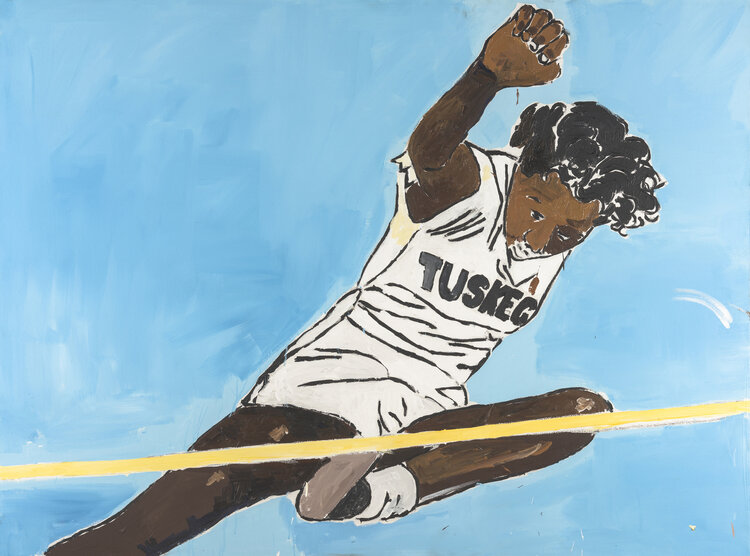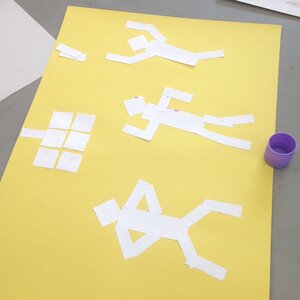Educator Resources are created by the Frye’s Education team to help teachers engage their students with our exhibitions and collections, but may also be enjoyed by others. This guide is written for educators working with students in grades 1-3 in the content areas of Visual Art and can be adapted for ELA, and Social Studies.
Activity length: approximately one hour
Grade level: 1-3
Download the Educator Resource Guide as a PDF
Depicting Bodies in Motion: Henry Taylor’s how i got over
Translating the physical movement of a figure onto a piece of paper can be challenging for students. Let’s break down the complexity of depicting the body in motion and explore how to guide students to think through the details with easy-to-manipulate visual aids. To start, let’s look at a painting from Black Refractions: Highlights from The Studio Museum in Harlem, a special exhibition at the Frye Art Museum through August 15, 2021.

Henry Taylor. how i got over, 2011. Acrylic on canvas. 56 1/8 × 75 1/2 in. The Studio Museum in Harlem; gift of Martin and Rebecca Eisenberg 2013.11.1. © Henry Taylor. Courtesy American Federation of Arts.
ARTWORK DISCUSSION
Spend the first 15 minutes or so exploring the painting visually with your students before providing any background information about the artwork. Use the following guiding questions to help them observe and connect with the artwork on a personal level. Before discussing the painting, ask your students to quietly look at this painting for a few moments on their own.
Other than the first question, there is no specific order in which the questions should be asked. Feel free to select proceeding questions based on the responses to the first question.
Guiding Questions
-
What is going on in this painting? What do you see that makes you say that?
-
What can you say about the figure in this painting? What are some clues in the artwork that tell you more about this person in particular?
-
Do you see movement in this painting? If so, how did the artist show movement?
-
Where do you think this might take place? What type of setting might this be?
-
Why do you think the artist chose not to provide a specific setting for the painting?
-
If this were a scene from a movie, what might happen next?
-
What does this painting remind you of?
-
The artist painted this image from a photograph. Where do you think the photographer was in relation to this figure the moment the photo was taken?
-
If you were to give this painting a title, what might it be?
ABOUT THE ARTWORK & ARTIST
Alice Coachman, the first Back woman to win an Olympic gold medal in 1947, is the central figure in the painting. As a high jumper, she set American and Olympic records with her first attempt at 5 feet 6 1/8 inches. Born in 1923 during an era of racial segregation in Georgia with no access to regular training facilities, Coachman created her own hurdles with tied rags, ropes, and sticks to practice jumping and ran barefoot in fields and on dirt roads as part of her training. At sixteen, she was awarded a scholarship to attend the high school program at Tuskegee Institute, one of the largest historically Black universities in the United States, in Tuskegee, Alabama. After entering the college division in 1943, she played on the basketball team and ran track and field, for which she won four national championships for events in sprinting and high jumping. At the 1996 Atlanta Olympics, she was honored as one of the 100 greatest Olympic athletes in history. In 2004, she was inducted into the U.S. Olympic Hall of Fame.
Los Angeles-based artist Henry Taylor painted this image of Coachman with her Tuskegee uniform from a photograph taken at the US National Women’s Track and Field meet in 1939. His portraits often draw from historical moments and personal memories while focusing on social and political issues as he explores the shared Black American experience. Taylor says, “My paintings are what I see around me…they are my landscape paintings.”
This painting is titled how i got over, recalling a song with the same title, “How I Got Over,” performed by Mahalia Jackson to introduce Martin Luther King' Jr.’s “I Have a Dream” speech. With Coachman’s fist pump in the air a triumphant gesture and a propelling thrust, Taylor references the accomplishment of getting over sociopolitical hurdles beyond the track.
Learn more about how i got over on The Studio Museum in Harlem’s website.
ART-MAKING ACTIVITY
Materials
-
9” x 12” construction paper (this will be used as the background paper for a collage)
-
Multiple pre-cut 1”x1” squares, 2”x1” rectangles, and 1.5” x 0.5” rectangles (either printer paper or newsprint work well)
-
Glue stick
-
Oil pastel
Activity Instructions
STANDARDS
National Core Arts Standards
CREATING
Anchor Standard 1: Generate and conceptualize artistic ideas and work.
Anchor Standard 2: Organize and develop artistic ideas and work.
Anchor Standard 3: Refine and complete artistic work.
PRESENTING
Anchor Standard 4: Select, analyze, and interpret artistic work for presentation.
Anchor Standard 5: Develop and refine artistic techniques and work for presentation.
RESPONDING
Anchor Standard 7: Perceive and analyze artistic work.
Anchor Standard 8: Interpret intent and meaning in artistic work.
CONNECTING
Anchor Standard 11: Relate artistic ideas and works with societal, cultural, and historic context to deepen understanding.
Common Core State Standards: English Language Arts
College and Career Readiness Anchor Standards for Speaking and Listening
CCSS.ELA-LITERACY.CCRA.SL.1
Prepare for and participate effectively in a range of conversations and collaborations with diverse partners, building on others’ ideas and expressing their own clearly and persuasively.
CCSS.ELA-LITERACY.CCRA.SL.2
Integrate and evaluate information presented in diverse media and formats, including visually, quantitatively, and orally.
CCSS.ELA-LITERACY.CCRA.SL.4
Present information, findings, and supporting evidence such that listeners can follow the line of reasoning and the organization, development, and style are appropriate to task, purpose, and audience.
Washington Social Studies Learning Standards, Grades K-5
H2: Understands and analyzes causal factors that have shaped major events in history.
H3: Understands that there are multiple perspectives and interpretations of historical events.
H4: Understands how historical events inform analysis of contemporary issues and events.
Lynn Chou
Manager of Youth and School Programs

